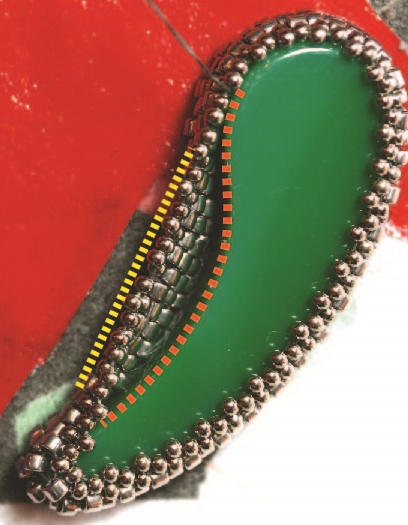I’ve sat through some pretty frustrating classes where the teacher insisted that I use double thread and wax. It drives me crazy. I understand that sometimes the engineering of the project demands that you use doubled thread and wax, but whenever possible I avoid it. I hate the feel of the wax and the double thread often makes it Impossible to go back and correct mistakes – and I make a lot of them. Double thread is really not necessary for bead embroidery. Instead of doubling, use a stronger test thread or reinforce your work.
Some beaders swear by a specific thread, length of thread, needle or tool. I almost always tell my classes to do what is comfortable for them. If you like wax, use it. Or don’t—beading is supposed to be fun. How much thread? You decide.
Use the information below to make your own decisions. Just have fun.
Thread Conditioners: To Wax or Not
One of the great things about bead embroidery is the ease of changing your mind. If you don’t like how something looks or you want to correct an error, just remove your needle and pull the beads off. Unfortunately, this makes any thread fray, especially if you split your thread as you pass through beads more than once. In addition, using thread lengths in excess of three yards causes wear and tear on the thread. When the eye of your needle is rough, the thread in the eye gets frayed and worn, and the eye itself may break due to pulling.
A major “controversy” in beading is thread conditioning. Some beaders swear by beeswax, microcrystalline wax or Thread Heaven. An equal number use neither. You can decide what you prefer with experience.
Beeswax has been used for many years but has been largely replaced with microcrystalline wax, a man made, petroleum product that does not dry out or get hard like Beeswax. Both add body to the thread which helps maintain tension. Because microcrystalline is not organic, it doesn't break down over time. Microcrystalline is easy to apply and less sticky or messy.
If you have a lot of wax build up in the bead holes, you are using too much wax. This will also build up in the eye of the needle and you will not be able to thread the needle eventually. Hold the needle in your hand or hold it up to a lamp to warm the wax and clear the needle's eye.
Thread Heaven is not a wax. It is a lubricant that repels thread from itself to prevent knotting. Since most knots happen when the cut end of the thread twists around the main part, the manufacturer recommends that you keep the cut end coated with a thread conditioner. How to Use Thread Heaven









![1505449_1491439087808855_6401519450727431897_n[2].jpg](https://images.squarespace-cdn.com/content/v1/53599144e4b0113e0b6839c9/1420465066859-9ONY9BGLVUXAPP98AZ8D/1505449_1491439087808855_6401519450727431897_n%5B2%5D.jpg)












































